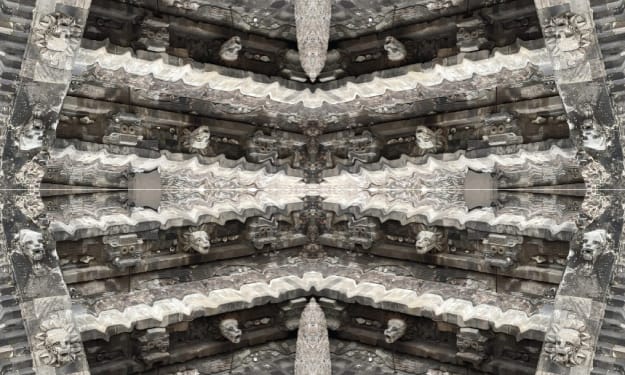
Nutrition is the biochemical and physiological process by which an organism uses food to support its life. It provides organisms with nutrients, which can be metabolized to create energy and chemical structures. Failure to obtain sufficient nutrients causes malnutrition. Nutritional science is the study of nutrition, though it typically emphasizes human nutrition.
see caption
An Amblypodia anita (purple leaf blue butterfly) gathering nutrients from guano
The type of organism determines what nutrients it needs and how it obtains them. Organisms obtain nutrients by consuming organic matter, consuming inorganic matter, absorbing light, or some combination of these. Some can produce nutrients internally by consuming basic elements, while some must consume other organisms to obtain pre-existing nutrients. All forms of life require carbon, energy, and water as well as various other molecules. Animals require complex nutrients such as carbohydrates, lipids, and proteins, obtaining them by consuming other organisms. Humans have developed agriculture and cooking to replace foraging and advance human nutrition. Plants acquire nutrients through the soil and the atmosphere. Fungi absorb nutrients around them by breaking them down and absorbing them through the mycelium.Nutrients are substances that provide energy and physical components to the organism, allowing it to survive, grow, and reproduce. Nutrients can be basic elements or complex macromolecules. Approximately 30 elements are found in organic matter, with nitrogen, carbon, and phosphorus being the most important.[5] Macronutrients are the primary substances required by an organism, and micronutrients are substances required by an organism in trace amounts. Organic micronutrients are classified as vitamins, and inorganic micronutrients are classified as minerals.[6]
Nutrients are absorbed by the cells and used in metabolic biochemical reactions. These include fueling reactions that create precursor metabolites and energy, biosynthetic reactions that convert precursor metabolites into building block molecules, polymerizations that combine these molecules into macromolecule polymers, and assembly reactions that use these polymers to construct cellular structures.[5]
Nutritional groups
edit
Main article: Primary nutritional groups
Organisms can be classified by how they obtain carbon and energy. Heterotrophs are organisms that obtain nutrients by consuming the carbon of other organisms, while autotrophs are organisms that produce their own nutrients from the carbon of inorganic substances like carbon dioxide. Mixotrophs are organisms that can be heterotrophs and autotrophs, including some plankton and carnivorous plants. Phototrophs obtain energy from light, while chemotrophs obtain energy by consuming chemical energy from matter. Organotrophs consume other organisms to obtain electrons, while lithotrophs obtain electrons from inorganic substances, such as water, hydrogen sulfide, dihydrogen, iron(II), sulfur, or ammonium.[7] Prototrophs can create essential nutrients from other compounds, while auxotrophs must consume preexisting nutrients.[8]
Diet
edit
Main article: Diet (nutrition)
In nutrition, the diet of an organism is the sum of foods it eats.[9] A healthy diet improves the physical and mental health of an organism. This requires ingestion and absorption of vitamins, minerals, essential amino acids from protein and essential fatty acids from fat-containing food. Carbohydrates, protein and fat play a major role in ensuring the quality of life, health and longevity of the organism.[10] Some cultures and religions may have restrictions on what is acceptable for their diet.[11]Nutrient cycle
edit
Main article: Nutrient cycle
A nutrient cycle is a biogeochemical cycle involving the movement of inorganic matter through a combination of soil, organisms, air or water, where they are exchanged in organic matter.[12] Energy flow is a unidirectional and noncyclic pathway, whereas the movement of mineral nutrients is cyclic. Mineral cycles include the carbon cycle, sulfur cycle, nitrogen cycle, water cycle, phosphorus cycle, and oxygen cycle, among others that continually recycle along with other mineral nutrients into productive ecological nutrition.[12]
Biogeochemical cycles that are performed by living organisms and natural processes are water, carbon, nitrogen, phosphorus, and sulfur cycles.[13] Nutrient cycles allow these essential elements to return back into the environment after being absorbed or consumed. Without proper nutrient cycling, there would be risk of change in oxygen levels, climate, and ecosystem function.
Foraging
edit
Main article: Foraging
A bonobo fishing for termites with a prepared stick
Foraging is the process of seeking out nutrients in the environment. It may also be defined to include the subsequent use of the resources. Some organisms, such as animals and bacteria, can navigate to find nutrients, while others, such as plants and fungi, extend outward to find nutrients. Foraging may be random, in which the organism seeks nutrients without method, or it may be systematic, in which the organism can go directly to a food source.[14] Organisms are able to detect nutrients through taste or other forms of nutrient sensing, allowing them to regulate nutrient intake.[15] Optimal foraging theory is a model that explains foraging behavior as a cost–benefit analysis in which an animal must maximize the gain of nutrients while minimizing the amount of time and energy spent foraging. It was created to analyze the foraging habits of animals, but it can also be extended to other organisms.[16] Some organisms are specialists that are adapted to forage for a single food source, while others are generalists that can consume a variety of food sources.[17]
About the Creator
Enjoyed the story? Support the Creator.
Subscribe for free to receive all their stories in your feed. You could also pledge your support or give them a one-off tip, letting them know you appreciate their work.





Comments
There are no comments for this story
Be the first to respond and start the conversation.